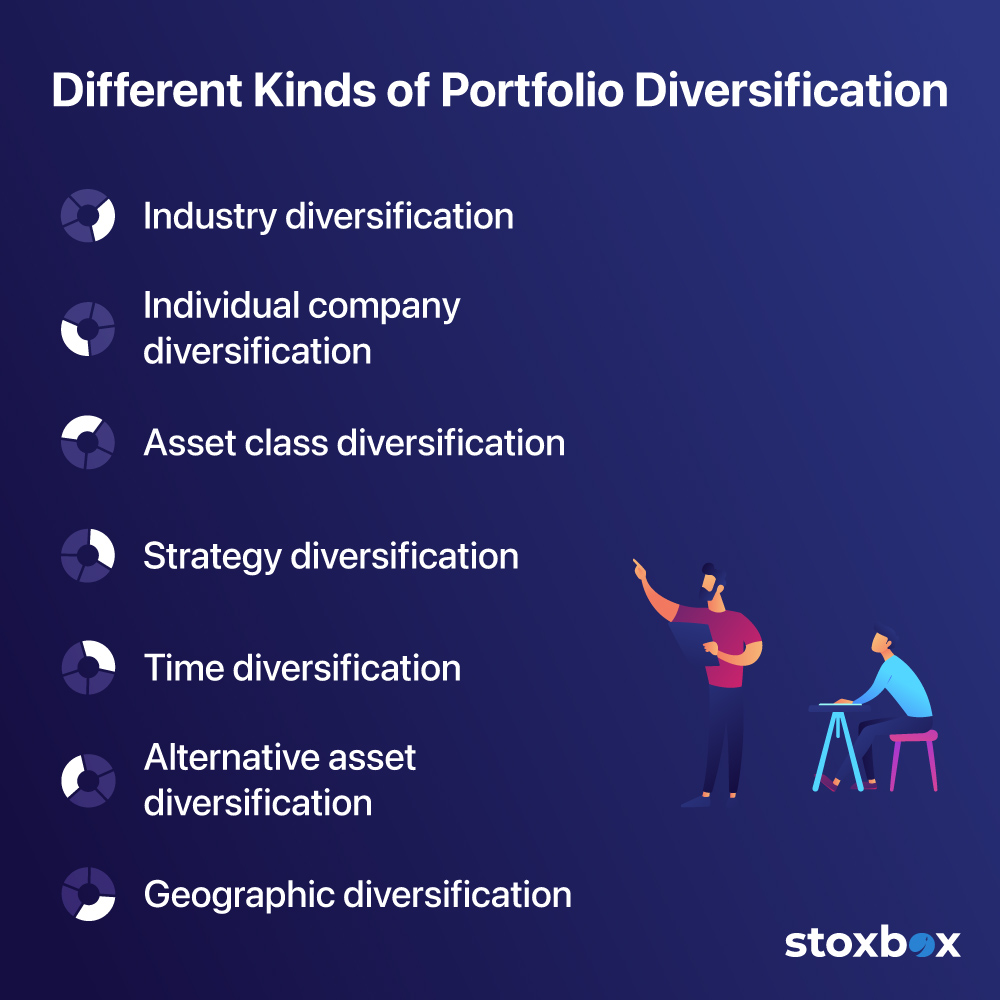Portfolio diversification enables investors to put their funds in a variety of investment avenues to reduce the overall risk. This is the most integral part of portfolio management for investors. There are many ways in which one can achieve portfolio diversification.
What is portfolio diversification?
Think of portfolio diversification like not keeping all your valuables in one place. If something goes wrong with one, the others stay safe. That’s the core idea here.
Portfolio diversification means spreading your money across different types of investments – like stocks, bonds, real estate, or even across industries and countries. The goal? To reduce the risk that comes from relying too much on one type of investment.
Let’s say one sector crashes or a specific company performs poorly – if your entire investment is tied to that, you’re in trouble. But if you’ve spread your investments smartly, one bad apple won’t spoil the bunch. Diversification doesn’t guarantee profits or fully eliminate risk, but it helps cushion your overall portfolio from unexpected shocks.
The importance of not over-diversifying
Just like everything else in life, diversification should also be done in the right measure. Diversification is used to manage the inherent risk in an asset or portfolio alone and does not help in eliminating the market risk. The most technical way of conducting the diversification exercise is to assess the risk of a portfolio and add negatively correlated assets until the measure of risk reduces considerably. The overall risk of the portfolio cannot be eliminated completely, and hence, in this pursuit, one can often end up diversifying the portfolio. It is important to know when to stop diversification, and this can be gauged by assessing the units of risk reduced by adding a new asset.
Often, over-diversification not only leads to an unmanageable portfolio but also reduces the portfolio’s returns without any meaningful risk reduction. It is important to execute the right quantum of diversification as much as it is important to use the right kind of diversification.
Different kinds of diversification

There are various methods of portfolio diversification, the choice should depend on the objective with which one is making the investment. It also depends on the level of understanding, knowledge and experience to implement the right method of diversification.
Industry diversification
Industry diversification refers to adding negatively correlated industries into the portfolio or sectors with different risk profiles. This will help the portfolio weather various cycles in the market. This is a part of the top-down view of investing which is often followed in thematic investing as well. Thematic funds are broader-based than sectoral funds, they provide diversification across related industries. For example, a fund with theme infrastructure can invest in real estate, cement, power, steel, etc.
Individual company diversification
A very popular method of diversification is evaluating investment at an individual company level. Here, the portfolio manager would gain deeper insight into the company’s fundamentals and business operations and identify those which are likely to be negatively correlated. The classic portfolio optimizer strategies such as the variance model and the expected return use the individual company diversification method.
Asset class diversification
It is an ideal proposition to first build a portfolio that includes various asset classes since different assets react differently to changing economic scenarios and diversify within each asset class. There has been enough academic and real-world evidence that equity and gold markets move in opposite directions on many occasions. In an inflationary environment, commodities including gold and cash tend to outperform other asset classes. During deflationary trends, long-term bonds and government bonds with long tenures are preferred. Furthermore, the market cycles for all the assets vary, while adding different assets enables one to align investments in line with the timelines of various financial goals. Portfolio management companies initiate the portfolio design by this method of diversification and then efficiently combine them with other complementary methods.
Strategy diversification
There are various strategies adopted to manage portfolios – some of the well-known strategies are value investing, growth investing and contra investing. Many companies which conduct portfolio management in India and across the globe adopt a combination of these strategies. They may use multiple strategies at a single point in time or align strategy with the market cycle. There are many new strategy diversification methods such as factors, smart beta, etc., which are often used by portfolio management companies.
Time diversification
The best example for time diversification is a systematic investment plan; this is considered an ideal method to invest in equity and equity-related instruments such as mutual funds. The essence of systematic investment is rupee-cost averaging. Portfolio diversification with ETFs (exchange-traded funds) will offer diversification across companies. By investing via SIP, one can achieve time diversification as well. This is one of the many ways in which one can combine multiple diversification methods to reduce overall risk.
Alternative asset diversification
Alternative asset diversification is a relatively new phenomenon, wherein individuals/portfolio managers seek diversification by investing in instruments including art, private equity, venture capital, distressed securities, antiques, etc. This method of diversification is often used when the corpus invested is significantly high.
Geographic diversification
Country risk and currency risk can be countered effectively by expanding one’s investment across various countries. By gaining exposure in developed economies and emerging markets, one is able to participate in a stable economy and another which provides faster growth.
Conclusion
Diversification for young investors does not consider diversification due to lower quantum of funds and lack of expertise and knowledge. While hiring experts and professionals can be an expensive and daunting task for millennials, they can take the help of the Stoxbox app which can be downloaded on Playstore or IOS phone. So, you can get help at your fingertips!
Ratan started his explanation with a simple analogy. He said, ‘Prem, have you ever heard of the adage, don’t put all your eggs in one basket?’ Well, investing is similar in nature. You don’t put all your investments in the same asset class’. Delving deeper, he explained that every asset class and even investment has a specific risk and return potential. At the same time, different asset classes respond differently to the same set of events or developments. When you diversify your portfolio across multiple asset classes, you ensure that sharp, negative movements in any one asset class do not have an inordinately large impact on your portfolio. By doing this, you are able to reduce the overall risk of your portfolio.
Prem was immediately able to appreciate the importance of portfolio diversification. Now, all he wanted to know was how he could achieve optimal portfolio diversification. To this Ratan replied that Prem could simply diversify his investment portfolio the same way that he had. So, Prem went about copying Ratan’s portfolio diversification strategy and invested 70% in equities, 25% in debt, and 5% in gold. Unfortunately for Prem, this was not great advice.
Even though both Prem and Ratan are of the same age, there are stark differences in their income levels and lifestyle. Ratan is single, has no loans, and is earning Rs. 1,00,000 per month. Prem recently got married, has an education loan to pay off, and is currently earning Rs. 85,000 per month. The amount of risk that Prem can potentially take is far lower than the risk that Ratan can take. Accordingly, a 70% allocation to equities is very high for someone like Prem. What Prem should ideally do is consult a financial advisor and assess his risk profile and return objectives. Once that is determined, then based on his unique risk profile and return objectives, he should create a portfolio diversification strategy. The key to making portfolio diversification work is to create a personalised portfolio diversification plan. The three main things that you need to focus on to achieve that include:
Your risk profile: This takes into consideration your willingness and ability to take risks. While your ability to take risk can be measured by assessing your current income and liabilities, your willingness to take risk cannot be easily measured. However, you can take a few psychometric tests to understand your comfort with taking risks. Together, these two will determine your risk profile.
Your return requirements: At the end of the day, the reason you save and invest is to generate sufficient returns to meet your financial goals. If you take too little risk and generate minimal returns, then you will not be able to achieve your financial goals, thereby defeating the very purpose of investing. Thus, take a step back and understand why you are investing, how much money you need to achieve each individual goal, how much money you can invest, and therefore, what are your return requirements.
Your investment time horizon: This indicates the time period for which you can stay invested and also has an impact on the level of risk that you can take. If your investment time horizon is short-term in nature, then you will be able to take very little to no risk. This means that equities might not be a viable option for you. On the other hand, if your time horizon is long-term in nature, i.e., greater than 5 years, then you might be able to take higher risk and invest in equities.
When creating a portfolio diversification strategy, you must focus on what works best for you. This is the reason why an optimal portfolio diversification strategy should be personalised and should be aligned with your unique risk-return requirements.
Frequently Asked Questions
What is portfolio diversification, and why is it important?
Portfolio diversification involves spreading investments across various asset classes, sectors, or geographies to reduce risk. It helps ensure that a negative event in one asset class or sector does not significantly impact the overall portfolio.
What are the different types of portfolio diversification?
Portfolio diversification can be achieved through:
- Industry diversification: Investing in multiple sectors.
- Asset class diversification: Spreading investments across equities, bonds, gold, etc.
- Geographic diversification: Investing in different countries to counter country-specific risks.
- Strategy diversification: Combining value, growth, and contra investing strategies.
- Time diversification: Using methods like SIPs to spread investments over time.
- Alternative assets: Investing in art, private equity, or venture capital.
What is the risk of over-diversification?
Over-diversification can lead to a complex, unmanageable portfolio, diluting returns without significantly reducing risk. It’s essential to balance diversification to achieve meaningful risk reduction and return optimization.
How should I determine my portfolio diversification strategy?
Your strategy should align with:
- Risk Profile: Assess your ability and willingness to take risks.
- Return Requirements: Understand your financial goals and the returns needed to achieve them.
- Investment Time Horizon: Longer horizons allow for higher risk investments like equities, while shorter horizons may require safer options.
What role does asset class diversification play?
Asset class diversification helps balance a portfolio by including assets that respond differently to economic scenarios. For example, equities and gold often have inverse relationships, providing stability during market volatility.
How does geographic diversification reduce risk?
Geographic diversification reduces country-specific risks like political instability or currency fluctuations. By investing in both developed and emerging markets, investors can balance stability with growth potential.
Why is personalized portfolio diversification important?
A one-size-fits-all approach doesn’t work in portfolio diversification. Factors like income, liabilities, risk tolerance, and financial goals differ for everyone. A personalized strategy ensures alignment with individual needs and objectives for optimal outcomes.
Your Wealth-Building Journey Starts Here

You might also Like.
Union Budget 2025-26 Impact on Sectors
Edit Announcement Impact Companies Enhancing the credit guarantee cover for...


